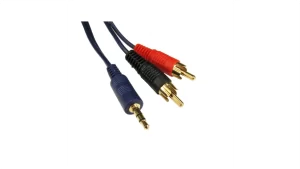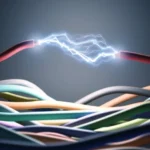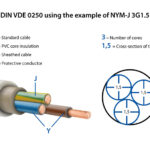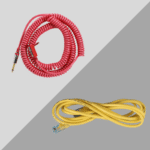An RCA cable (often referred to as phono cable or composite cable) is a type of electrical cable used to carry audio and video signals between devices. Developed in the 1940s by Radio Corporation of America (RCA), this cable became a standard for connecting home audio and video equipment, and remains widely used today despite the rise of more advanced technologies like HDMI and DisplayPort.
RCA cables are particularly recognized for their distinctive color-coded connectors—typically red, white, and yellow—that make it easy to identify audio and video connections. While it’s an older technology, the RCA cable continues to be valuable for both analog audio and video applications.

what is rca cable
How Does an RCA Cable Work?
An RCA cable transmits audio and video signals in analog form. The cable consists of multiple wires (typically made of copper) and is protected by an insulating layer and an outer shield to minimize signal interference.
RCA connectors typically come in a male version, meaning they have metal pins that plug into female jacks on devices. For example:
The red RCA connector is used for right-channel audio (audio in stereo).
The white RCA connector is used for left-channel audio.
The yellow RCA connector is used for video (usually composite video).
In some cases, an RCA cable may only include the red and white connectors, especially for audio-only connections, or just the yellow connector for video-only setups.
Types of RCA Cables
Composite RCA Cables (Standard):
These cables are typically color-coded as red (right audio), white (left audio), and yellow (video). Composite RCA cables are the most common type and are used to transmit analog video along with stereo audio signals.Component RCA Cables:
Component cables separate the video signal into three parts: Y (luminance), Pb (blue chroma), and Pr (red chroma). They provide higher video quality than composite cables, making them suitable for HD resolutions. These cables are color-coded as red, green, and blue for video, with separate red and white connectors for audio.RCA Audio Cables:
These are two-wire cables that carry stereo audio signals (red for right, white for left). They are commonly used to connect audio equipment such as amplifiers, speakers, turntables, and AV receivers.RCA S-Video Cables:
S-Video is a type of analog video signal that separates the video signal into two components: luminance (Y) and chrominance (C). An RCA S-Video cable uses a special connector to improve video quality, often used for connecting DVD players and gaming consoles to older TVs or monitors.
Common Uses of RCA Cables
Home Audio Systems:
RCA cables are commonly used to connect various audio components such as speakers, amplifiers, receivers, and audio players. The red and white connectors typically carry stereo audio signals, ensuring that both the left and right audio channels are transmitted properly.Connecting to Televisions:
RCA cables were once the standard way to connect DVD players, game consoles, and VHS players to television sets. Although HDMI has largely replaced RCA for modern high-definition video, RCA cables are still used in older TV models and analog video equipment.Home Theater Systems:
Many home theater systems use RCA cables for connecting audio and video components. For instance, they can connect subwoofers, audio receivers, or DVD players to a TV or projector.Connecting Audio/Visual Devices:
RCA cables are still widely used in many old-school electronics, such as turntables, VCRs, and CD players, for connecting to TVs, speakers, and other devices that use analog audio and video signals.Legacy Audio-Video Equipment:
For those still using older audio and video devices, RCA cables are often necessary to ensure connectivity. This includes connecting legacy equipment like CRT TVs, VHS players, and older DVD players to modern AV systems.
Advantages of RCA Cables
Simple and Cost-Effective:
RCA cables are inexpensive, easy to use, and widely available, making them an attractive option for basic audio and video setups.Wide Compatibility:
RCA connectors are compatible with a wide range of devices, especially older audio and video equipment, making them versatile in many home and professional settings.Effective for Analog Signals:
For systems that don’t require high-definition video or digital audio, RCA cables provide a solid, reliable solution for analog signal transmission.Flexible for Basic Setups:
RCA cables can be used to build simple audio and video connections without the need for complex setups. They are especially useful for audio-only or video-only connections in legacy systems.
Disadvantages of RCA Cables
Limited Bandwidth and Quality:
RCA cables support analog signals, meaning they are not suitable for high-definition video or lossless digital audio. The quality can degrade over long distances, and the signal is more susceptible to interference compared to modern digital cables like HDMI.No Support for Digital Signals:
RCA cables cannot carry digital signals like HDMI cables can. This limits their use for modern systems that require 4K video, high-definition audio, or digital data transfer.Cluttered Connections:
Using multiple RCA cables for audio and video signals can result in cluttered setups with many cables running between devices. This is especially cumbersome for systems that require multiple connections for stereo audio and video.
Conclusion
An RCA cable is a reliable, easy-to-use solution for connecting older audio and video equipment. Despite being replaced by more modern technologies like HDMI for high-definition needs, RCA cables remain widely used for analog audio and video systems. If you are still using legacy equipment or have basic connectivity needs, RCA cables are a cost-effective and versatile option.
While their usage has declined in the age of digital signals, RCA cables continue to serve as a vital connection method in certain scenarios, especially for those with older home entertainment systems or professional analog setups.





